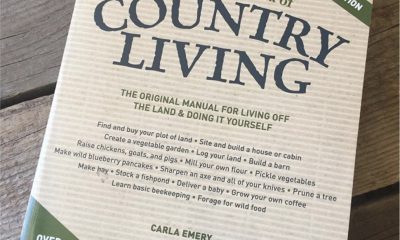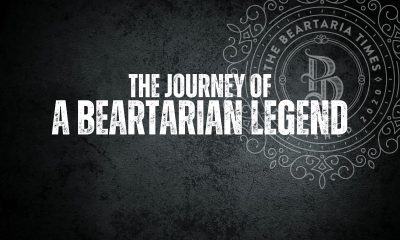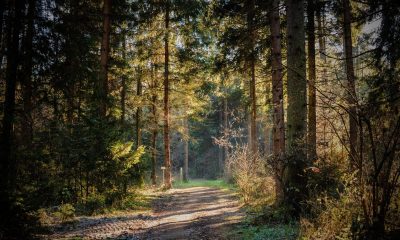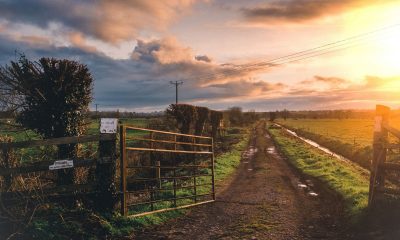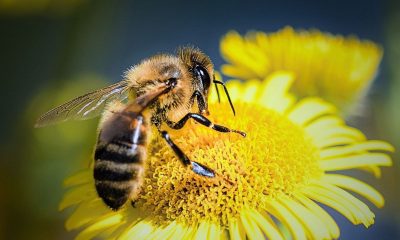Medieval Greenhouse On The Prairie
Nighthawk Bear takes us through his geothermal timber frame greenhouse build.
Building a Wyoming Geothermal Timber Frame Greenhouse
Welcome to the MOST difficult building project I’ve ever done. This is the beginning of what will soon be a Geothermal Timber Frame Greenhouse. Once it’s completed, I will be able to grow citrus and jungle plants in Wyoming. Who knows, I may even breed jungle panthers! All that’s needed is a stabile temperature around 50 degrees in the winter, and the right soil conditions (also maybe kevlar clothing if the panthers get frisky). I am currently focused on the structure and the temperature systems. I’ll try to explain why I’m doing this crazy thing, and how it will be accomplished.

I enjoy drinking lemon water in the morning, as it’s a great way to keep my body alkaline. It occurred to me that I could get citrus with far better quality if I grew it myself. Also, I want to help my family become less dependent upon grocery stores and long supply chains. In order to grow food year round, I would need a strong, climate controlled structure. I’ve held a fascination with medieval timber construction, and have also been inspired to build something like an old English garden greenhouse. It has been a grueling learning process, but my purpose is what keeps me motivated. A geothermal greenhouse will provide a well appreciated stable food supply even in the cold months.
Inspiration Precedes Perspiration
So how did I learn growing citrus in Wyoming was even theoretically possible? Once I heard of a man who inherited some land about 5,000 feet above sea level in the Austrian Alps named Sepp Holzer. He used permaculture in such a way that he was able to grow citrus trees in the mountains. Holzer, developed an understanding of the ecosystem and learned to mimic nature to help the land produce fruit. Unlike the Alps, nothing much grows on the plains. Grass doesn’t even grow here very well. It’s very dry where I live. When the clouds do bring moisture, it’s in the form of snow and -15degree temperatures. However, we do have a lot of sunshine. This is the number one ingredient in Florida oranges, if the commercials are correct. So instead of complaining about not being able to grow things easily, I took an extreme right turn and decided to create a way to grow just about anything.
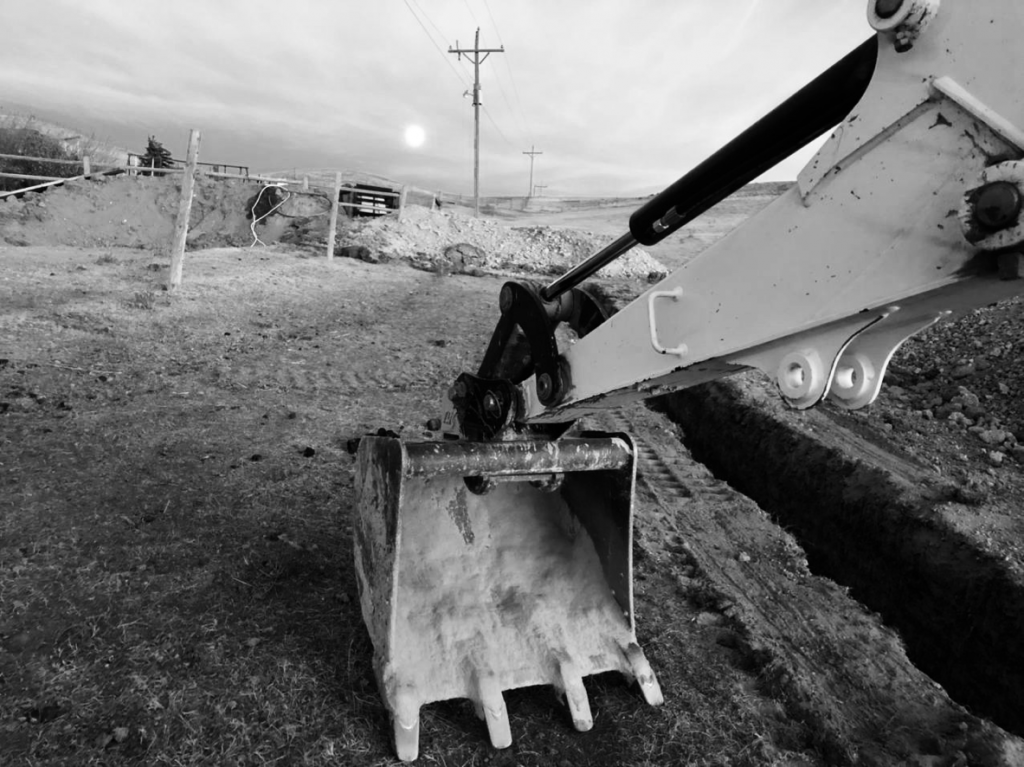
Prepare the Battlefield
The first obstacle to building the greenhouse was the terrain. We live on a hill and needed to dig into the side of it in order to create a level area for the greenhouse. In doing this, we create about a 10ft earth wall at one end of the greenhouse. The earth will be lined with black rubber sheeting that will absorb the heat from the sun and warm the earth behind it. The stored heat will warm the greenhouse during the cold nights.
Additionally, I dug a 175ft long trench at a depth of 8ft. In the bottom of the trench I buried three corrugated plastic tubes that will be used to circulate air. The air at 8ft below the surface has a stable temperature at about 54 degrees Fahrenheit. This air will help warm the greenhouse in the winter, and cool it in the summer. For good measure, I also plan to circulate air between two layers of plastic sheeting. The constant airflow will warm the walls facing the freezing outside temperatures. With these systems combined, I hope to keep the temperature inside the greenhouse at around 50 degrees Fahrenheit even when the windchill outside is -20degrees F.

Improvise, Adapt, and Overcome
Normally, when you build a timber frame structure, you get the correct size timber from a mill. However, I don’t have such a timber mill nearby. From day one, I was inventing ways to combine found materials to fulfill my timber needs. By the grace of God, my neighbor never throws away anything. I literally used a baby boomer’s scraps to build this project. Working day and night, I glued, bolted, and strapped boards together. Then, after the glue dried, I fired up the chainsaw and carefully rip-cut the new beams down to make my own 6×8’s.
There is still much work to do. I have finally finished measuring, cutting, and assembling the timber structure. This was the bulk of the heavy labor.
The video linked in this article will describe a little more in detail what I have done so far. I hope this will inspire you to grow and build your way out of Babylon. You don’t need to go to the extreme lengths that I have. Just build your families and communities. Shorten your supply chains every chance you get. Work to get out of debt. These are all primary goals I hope we all will accomplish and make a reality in our lives. If we continue to focus on these, we will begin to see a level of prosperity outside the system that will bless those around us for generations.
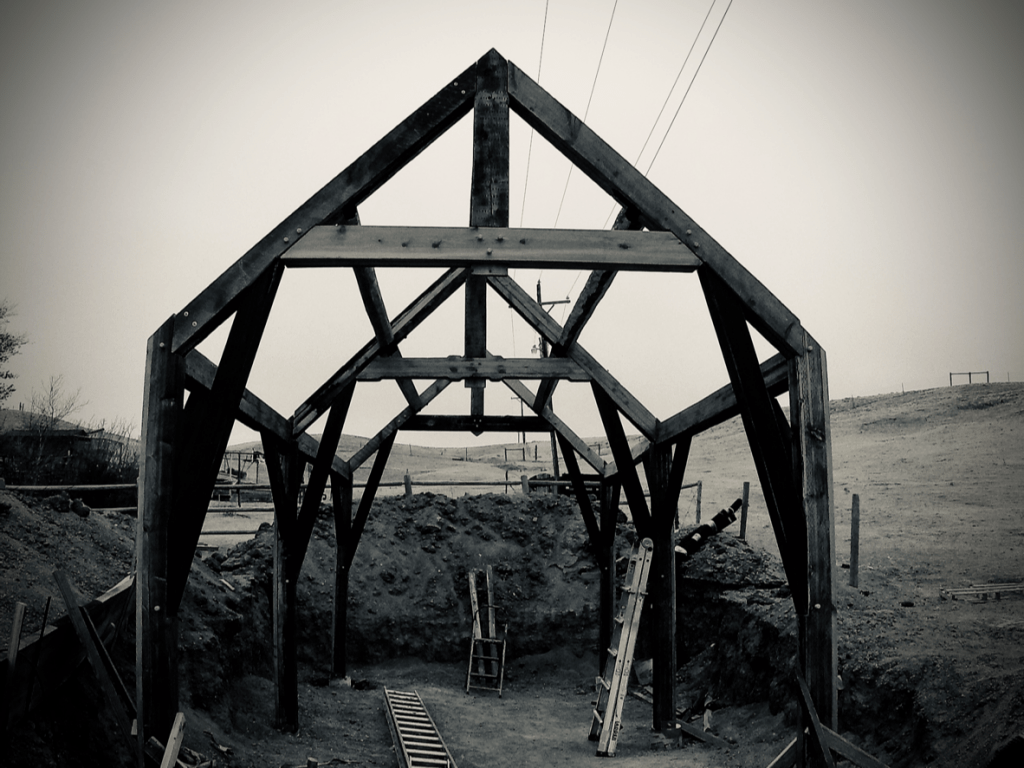
This is OUR new age. We’re not talking yoga mats, man buns, and trying to channel Elvis. Our new age is full of family, friends, love, faith, and hope. Onward.
Farming
Preserving the Harvest: Techniques for Long-Term Storage
Preserving your harvest is essential for enjoying homegrown produce year-round and reducing food waste.

Preserving your harvest is essential for enjoying homegrown produce year-round and reducing food waste. There are several methods to store fruits, vegetables, and herbs for the long term, each with its unique benefits. While you dream and plan for the bounty of your harvest, enjoy these highlights of various preservation techniques and tips for getting the best results.
Canning
Benefits: Canning allows you to store fruits, vegetables, and even meats for years. It’s a great way to preserve large quantities of produce at once.
Types:
– Water Bath Canning: Ideal for high-acid foods like tomatoes, pickles, and some fruits.
– Pressure Canning: Necessary for low-acid foods like vegetables, meats, and beans to ensure safety from botulism.
Steps:
1. Wash and sterilize canning jars and lids.
2. Wash, peel, and cut produce as needed.
3. Pack the produce into jars, leaving appropriate headspace.
4. Use a water bath or pressure canner according to the recipe’s instructions.
5. Let jars cool undisturbed. Check seals before storing them in a cool, dark place.
Freezing
Benefits: Freezing retains the nutritional value and flavor of fresh produce. It’s quick, easy, and suitable for a variety of foods.
Tips:
– Blanch Vegetables: Briefly boil vegetables and then plunge them into ice water to preserve color, texture, and nutrients.
– Proper Packaging: To prevent freezer burn use airtight containers or freezer bags.
– Labeling: Always label and date your packages for easy identification and rotation.
Steps:
1. Wash, peel, and chop produce as needed.
2. Blanch vegetables in boiling water, then cool in ice water.
3. Pat produces dry to avoid ice crystals.
4. Place produce in freezer-safe bags or containers, removing as much air as possible.
5. Store in the freezer at 0°F (-18°C) or lower.
Drying and Dehydrating
Benefits: Drying removes moisture from foods, preventing the growth of bacteria and mold. It’s energy-efficient and creates lightweight, shelf-stable foods.
Methods:
– Air Drying: Suitable for herbs, hot peppers, and certain fruits. Hang produce in a dry, well-ventilated area.
– Oven Drying: Use a low oven temperature (140°F/60°C) to dry fruits, vegetables, and herbs.
– Dehydrators: Specialized appliances that provide consistently low heat and air circulation for efficient drying.
Steps:
1. Wash, peel, and slice produce uniformly.
2. Use your chosen method, ensuring the produce is completely dry.
3. Store dried foods in loosely packed containers for a week, shaking daily to evenly distribute any remaining moisture.
4. Transfer to airtight containers and store in a cool, dark place.
Fermenting
Benefits: Fermentation enhances the nutritional value of foods, adds probiotics, and provides unique flavors. It’s a natural preservation method that requires minimal equipment.
Common Fermented Foods:
– Sauerkraut: Fermented cabbage, rich in probiotics.
– Kimchi: Spicy fermented vegetables, often including cabbage and radishes.
– Pickles: Cucumbers or other vegetables fermented in a brine solution.
Steps:
1. Clean and cut vegetables as needed.
2. Mix water and salt to create a brine solution. (Brine is only needed when pickling, fermented vegetables break down when salted and their water content becomes the “brine”)
3. Place vegetables in jars, pour brine over them, and ensure they are submerged.
4. Cover jars and let sit at room temperature for several days to weeks, depending on the recipe.
5. Once fermented to taste, transfer jars to the refrigerator.
Root Cellaring
Benefits: Root cellaring is an age-old method that allows for the long-term storage of root vegetables, apples, and other hardy produce without the need for canning or freezing.
Ideal Conditions:
– Cool Temperatures: Typically 32-40°F (0-4°C).
– High Humidity: 85-95% to prevent produce from drying out.
– Ventilation: Adequate air circulation to prevent mold and rot.
Steps:
1. Select vegetables and fruits that store well, such as carrots, potatoes, beets, and apples. (Apples release ethylene gas that can cause other produce to age or rot, be mindful when storing)
2. Avoid bruising produce during harvest.
3. Use bins, shelves, or sandboxes to store produce.
4. Regularly check temperature, humidity, and the condition of stored produce.
Using preservation techniques on your harvest allows you to enjoy the flavors and nutrients of homegrown produce throughout the year. However, you do not need a harvest to start on your preservation journey, these methods will allow you to bulk buy food that might usually go to waste. Learning these methods even before you begin to farm can give you a great start before you are swamped in a harvest.
Each preservation method has its unique advantages and is suitable for different types of produce. By mastering a variety of techniques—canning, freezing, drying, fermenting, and root cellaring—you can maximize your harvest’s shelf life and reduce food waste. Happy preserving!
Did you know we have an entire category group in our app just about Preserving that currently has more than 1,800 members following it due to shared interest in the topic?
If you are interested in submitting an article for BeartariaTimes.com as a guest writer please email Editor@BeartariaTimes.com.
Farming
The Rise of Small-Scale Farming: Benefits, Challenges, and Tips for Success
Looking beyond the pretty Instagram pictures.
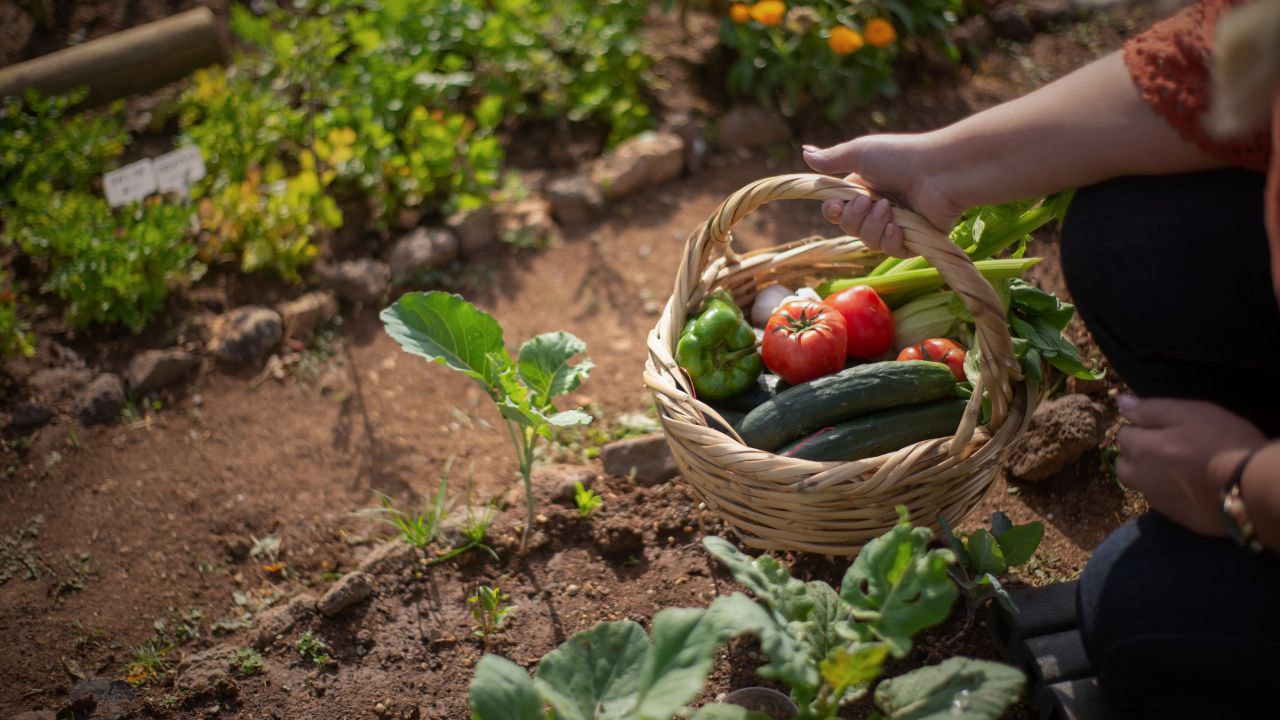
Small-scale farming has seen a significant resurgence in recent years. As more people seek sustainable and self-sufficient lifestyles, understanding the benefits and challenges of small-scale farming becomes increasingly important. This article highlights this trend and provides insights into what it takes to succeed as a small-scale farmer.
Benefits of Small-Scale Farming
1. Sustainability
Small-scale farms often adopt sustainable practices such as crop rotation, composting, and organic farming, which help maintain soil health and reduce environmental impact. Such practices support a more sustainable agricultural system.
2. Community Engagement
Small-scale farms can strengthen local communities by providing fresh, locally-grown produce. Farmers’ markets, community-supported agriculture (CSA) programs, and farm-to-table initiatives foster connections between farmers and consumers.
3. Diverse Crop Production
Unlike large monoculture farms, small-scale farms can grow a variety of crops. This diversity reduces the risk of crop failure and provides a wider range of fresh produce to the community.
4. Better Quality Produce
Small-scale farmers often prioritize quality over quantity. This focus on quality leads to fresher, more nutritious, and better-tasting produce compared to mass-produced alternatives.
5. Economic Resilience
Small-scale farming can contribute to local economies by creating jobs and supporting other local businesses. Farmers can also diversify their income through value-added products like jams, cheeses, and homemade goods.
Challenges of Small-Scale Farming
1. Limited Resources
Small-scale farmers often operate with limited financial resources and may struggle to access capital for equipment, seeds, and other necessary supplies. Managing cash flow can be challenging and requires additional planning and strategizing.
2. Labor Intensive
Small-scale farming is labor-intensive, requiring significant time and effort. Beyond the physically demanding work of planting and harvesting, farmers also have to invest energy into marketing and selling what they produce.
3. Market Access
Finding and maintaining a reliable market for produce can be difficult. Small-scale farmers must often compete with larger operations and navigate complex distribution networks to reach consumers.
4. Weather Dependence
Farming is inherently dependent on weather conditions. Droughts, floods, and extreme temperatures can all impact crop yields. Small-scale farmers must develop strategies to mitigate these risks.
5. Regulatory Hurdles
Navigating agricultural regulations and obtaining necessary permits can be challenging for small-scale farmers. You need to budget time and resources to achieve compliance with food safety standards, labeling requirements, and other regulations.
Tips for Success in Small-Scale Farming
1. Start Small and Scale Up
Begin with a manageable plot of land and expand gradually as your experience and resources grow. This approach reduces the risk of overwhelming yourself and allows for steady growth.
2. Diversify Your Products
Growing a variety of crops, and exploring value-added products, can increase your income and reduce risk. Consider niche markets and unique products to stand out.
3. Build a Strong Network
Connect with other farmers, local businesses, and agricultural organizations. Networking can provide valuable support, resources, and market opportunities.
4. Embrace Technology
Utilize modern farming techniques and technology to improve efficiency. Tools such as drip irrigation, soil sensors, and farm management software can enhance productivity and sustainability.
5. Focus on Marketing
Effective marketing is crucial for reaching consumers. Utilize social media, create a website, and utilize local markets and events to promote your farm and products.
Small-scale farming offers a rewarding path to sustainability and community engagement. While it presents challenges, the benefits of producing high-quality, diverse crops and contributing to local economies make it a worthwhile endeavor. With careful planning and dedication, small-scale farmers can thrive while also benefiting their community and the land they are stewarding.
Our app has thousands of members who post in our groups focused on Farming, Composting, Land Development and much more.
Come join the 15k+ members who are creating solutions and Crushing it!
If you are interested in submitting an article for BeartariaTimes.com as a guest writer please email Editor@BeartariaTimes.com.
Farming
The Buzz and Benefits of Beekeeping for Homesteaders
Whether you’re motivated by the prospect of fresh honey or the joy of working with these fascinating creatures, beekeeping is a fulfilling and valuable addition to any homestead.

Beekeeping is a rewarding practice that offers numerous benefits for homesteaders. Beyond producing delicious honey, beekeeping supports pollination, enhances biodiversity, and can even contribute to local economies. Here are some of the key benefits of beekeeping and why it might be a perfect addition to your homestead.
Benefits
- Honey Production
- A pure natural sweetener, honey is versatile and can be used as a natural remedy for various aliments, included in baking, or used in cooking. Home-harvested honey is free from additives and preservatives, ensuring a pure and natural product.
- Honey has health benefits it can soothe sore throats, aid in digestion, and provide a quick energy boost. It is known for its antioxidant and antibacterial properties.
- Selling honey and other hive products like beeswax candles or propolis can provide an additional source of income for homesteaders.
- Pollination
- Bees are essential pollinators for many crops, including fruits, vegetables, and nuts. By keeping bees, you can improve the pollination of your garden, offering better-quality produce and higher yields.
- By helping to pollinate a wide range of plants, bees contribute to having a greater biodiversity. This supports a healthier ecosystem and can enhance the resilience of your homestead.
- Healthy pollinator populations support other wildlife by contributing to the production of seeds and fruits that feed birds and other animals.
- Education and Enjoyment
- Beekeeping is an engaging and educational hobby. It provides a hands-on way to learn about the life cycle of bees, their behavior, and their critical role in the ecosystem. This can be a family-friendly activity that teaches children about responsibility, biology, and environmental stewardship.
- Additionally many beekeepers find tending to their hives to be a meditative and calming experience, providing a way to connect with nature and reduce stress.
- Environmental Benefits
- Beekeeping helps counter the habitat loss, pesticides, and disease that are contributing to the decline of bee populations. By providing a safe habitat and practicing sustainable beekeeping, you contribute to the conservation of these vital pollinators.
- Many homesteaders adopt organic beekeeping practices, which avoid the use of harmful chemicals. Not only is this healthier for beekeeping it can enhance your homestead overall and promote a cleaner environment.
- Beekeeping raises awareness about the importance of bees and the challenges they face. By becoming an advocate for bees, you can educate your community and encourage more environmentally friendly practices.
- Beeswax and Other Hive Products
- You can use beeswax to make candles, soaps, lip balms, and lotions. These products are natural and chemical-free, making them ideal for personal use or for selling at local markets.
- Propolis, a resin-like substance bees use to seal their hives, has antimicrobial properties and can be used in natural remedies and supplements.
- Royal Jelly is a nutrient-rich substance, produced by worker bees, is often used in skincare products and health supplements due to its potential wellness benefits.
Getting Started with Beekeeping
- Research and Education
Start by learning as much as you can about beekeeping. Search resources from books, to online coursed, and get in touch with local beekeeping associations. Understanding the basics of bee biology, hive management, and seasonal care is crucial.
- Choosing the Right Equipment
Invest in quality beekeeping equipment, including hives, protective clothing, and tools for managing your bees. Consider starting with a beginner’s kit that includes the essentials.
- Selecting Your Bees
Choose a bee species suited to your climate and environment. Common choices include Italian bees, known for their gentle nature, and Carniolan bees, valued for their hardiness and efficient honey production.
- Setting Up Your Hive
Place your hive in a location that provides good sunlight, protection from strong winds, and access to flowering plants. Ensure the area is safe and convenient for regular hive inspections.
- Regular Maintenance
Beekeeping requires regular maintenance, including monitoring hive health, managing pests, and harvesting honey. Regular inspections help you catch problems early and keep your bees healthy.
Beekeeping offers a multitude of benefits for homesteaders, from improving crop yields and supporting biodiversity to providing a source of income and natural products. With commitment the right knowledge, you can create a thriving apiary that enriches your homestead and contributes to the health of the environment. Whether you’re motivated by the prospect of fresh honey or the joy of working with these fascinating creatures, beekeeping is a fulfilling and valuable addition to any homestead.
Did you know we have an entire category group in our app just about Beekeeping that currently has more than 1,100 members following it due to shared interest in the topic?
If you are interested in submitting an article for BeartariaTimes.com as a guest writer please email Editor@BeartariaTimes.com.
-

 Lifestyle3 weeks ago
Lifestyle3 weeks agoIndependence Isn’t for Everyone
-

 Farming3 weeks ago
Farming3 weeks agoThe Rise of Small-Scale Farming: Benefits, Challenges, and Tips for Success
-

 Just Crushing2 weeks ago
Just Crushing2 weeks agoLegends Spiral Upwards: Embracing Timeless Attributes
-

 Farming3 weeks ago
Farming3 weeks agoThe Power of Community: How Local Groups Can Strengthen Homesteads
-

 Lifestyle2 weeks ago
Lifestyle2 weeks agoBuilding a Sustainable Off-Grid Home: A Fundamental Guide
-

 Just Crushing1 week ago
Just Crushing1 week agoComedian Owen Benjamin Disrupts The Comedy Scene
-

 Lifestyle2 weeks ago
Lifestyle2 weeks ago10 Essential Skills Every Homesteader Should Master
-

 Farming3 weeks ago
Farming3 weeks agoThe Buzz and Benefits of Beekeeping for Homesteaders











